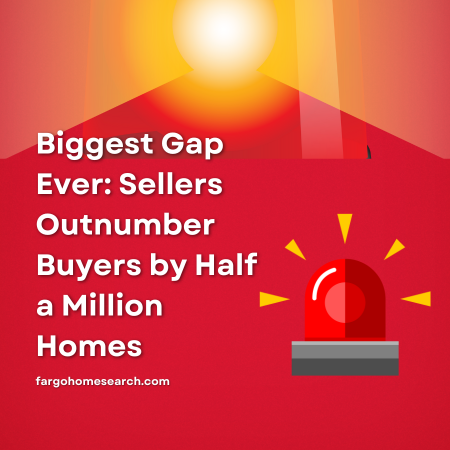Smart Real Estate Solutions
Fargo-Moorhead Real Estate Agents | Sell Your Home Confidently
![]() At Modern Market REALTORS®, Jim & Shannon combine deep local market expertise across Fargo, ND; Moorhead, MN; Horace, ND; and West Fargo, ND to deliver white-glove customer service—guiding you through every step of your home sale with seamless communication, strategic pricing, and confident results.
At Modern Market REALTORS®, Jim & Shannon combine deep local market expertise across Fargo, ND; Moorhead, MN; Horace, ND; and West Fargo, ND to deliver white-glove customer service—guiding you through every step of your home sale with seamless communication, strategic pricing, and confident results.
Home Sellers’ Surge Meets home Buyer Caution
As the U.S. housing market charts its slowest spring in more than a decade, a startling
imbalance has emerged: for every prospective buyer, there are now significantly more sellers. According to
recent data, there are over 508,000 more homes listed for sale than there are buyers actively seeking to purchase them—a gap not seen since the mid-2010s (The Economic Times). This divergence reflects both the enduring impact of high mortgage rates and evolving demographic patterns that have reshaped supply and demand.
Table of Contents
- What factors are driving the current surge in home sellers?
- How have demographic shifts influenced seller volume?
- Why are prospective buyers exercising caution in this market?
- How are rising mortgage rates impacting buyer affordability?
- What regional trends are we seeing in Fargo-Moorhead?
- How are investors affecting market dynamics?
- What strategies can sellers use to stand out in a crowded market?
- What is the forecast for inventory and price trends?
Despite sturdy economic indicators elsewhere, potential buyers have been sidelined by affordability headwinds. The National Association of Realtors (NAR) reports that, as of March 2025, the national supply of existing homes stood at 4.4 months—up from just 3.2 months a year earlier (Bankrate). In real-estate parlance, a balanced market hovers around six months of supply; fewer than that signals a sellers’ market. Yet the notable year-over-year increase underscores a shift—sellers are listing in greater numbers even as buyers hesitate.
“We have not seen conditions like this in over a decade,” notes Jim Christl of Modern Market REALTORS®, who has been active in the Fargo-Moorhead region for more than twenty years. “In 2025, we’re witnessing homeowners seize equity gains and relocate, yet a significant portion of would-be buyers are stepping back, waiting for mortgage rates to ease.”
Christl’s observations echo national trends: mortgage rates have averaged near 7% in recent months, stifling many first-time and move-up families (National Association of REALTORS®).
The regional picture mirrors the national imbalance. In the Upper Midwest, pending home sales fell by 6.3% in April compared to the same period last year, according to NAR’s forward-looking indicator of contract signings (National Association of REALTORS®). Local agents such as Shannon Barnum, Christl’s partner at Modern Market REALTORS®, highlight an influx of listings in Cass County and Clay County over the past quarter. “While inventory has climbed,” Barnum says, “buyer traffic is down nearly 15% from spring 2024 levels in our markets. It’s decidedly a sellers’ market—though ‘sellers’ might soon find themselves competing more fiercely than in years past.”
I. The Demographic Shifts Behind the Surge in Sellers
1. Aging Toward Equity Cash-Out
Households aged 60 and older now account for 53% of all home sellers, according to NAR’s 2025 generational trends report, up from 47% in 2023 (Virginia REALTORS®). Baby boomers are cashing in on decades of price appreciation—nationally, home prices have risen approximately 45% since 2019. The wealth effect has prompted many to downsize or relocate to amenity-rich retirement communities, swelling the ranks of homes on the market.
2. Delayed Move-Up and Move-Down Decisions
Conversely, younger cohorts have been slower to transition. First-time buyers constitute just 24% of transactions, down from 32% in 2023 (Seattle King County REALTORS®). High interest rates have encouraged some to delay purchases, while others opt for rental alternatives. As these younger segments remain inert, existing homeowners are more likely to list, tipping the scales further toward seller volume.
3. Global Capital Flows
International investors, particularly from Asia, have increasingly targeted U.S. real estate as a hedge against economic uncertainty in their home markets. Chinese buyers, facing a domestic property slump, accounted for 11% of foreign purchases in the U.S. in 2024, up from 8% in 2022 (The Economic Times). This influx partially offsets domestic buyer hesitancy but may inflate prices in select markets, complicating affordability further.
Affordability Challenges and the Buyer Pause
1. Mortgage Rate Drag
After peaking at 7.2% in December 2024, the average 30-year fixed mortgage rate has hovered near 6.8% in mid-2025 (NORADA Real Estate). Each full percentage point increase reduces a borrower’s purchasing power by roughly 10%, pricing millions of households out of their desired price bracket. For a median-priced U.S. home of $415,000, that equates to an additional $100 in monthly payments for every $100,000 borrowed.
2. Income-Based Purchasing Power Declines
Middle-income households earning $50,000 annually can now afford only 8.7% of listed homes, down from 9.4% a year ago (National Association of REALTORS®). Even $75,000 earners see purchasing power curtailed—able to access just 21.2% of listings. As homeownership becomes less attainable, rental demand has spiked, with national vacancy rates dropping to 5.8% in Q1 2025 from 6.3% in 2024 (U.S. Census Bureau). This shift has prompted some investors to convert unsold listings into rentals, reducing for-sale inventory in select markets but further discouraging first-time buyers who face rising rents—up 4.2% year-over-year. While modest salary gains have occurred, they have not kept pace with home-price inflation, forcing many buyers to pause or continue renting.
Regional Ripples: Fargo-Moorhead and Beyond
In the Fargo-Moorhead metro, elevated equity and local job growth have driven up listings by 28% year-over-year, according to county property records. Yet buyer showings have plateaued, with open-house attendance down 12% compared to spring 2024. Christl and Barnum report an uptick in price reductions as sellers confront longer days on market; nearly 20% of active listings experienced at least one price cut in May—double the rate from the same month last year.
The Investor Interlude
Amid the imbalance, cash buyers and investors have stepped in. All-cash transactions accounted for 28% of national sales in June—a slight uptick from last year (National Association of REALTORS®). Private equity and institutional investors, seeking rental properties, have also expanded portfolios, especially in lower-tier markets where affordability thresholds remain more favorable. This dynamic subtly shifts the balance: while it soaks up some supply, it further sidelines owner-occupant buyers.
The Condo Contrarian
The condominium market tells a slightly different story: supply has surged by 10%, and average prices have fallen 1.4%—the weakest performance since 2012 (The Wall Street Journal). High homeowner-association dues and lingering safety concerns in coastal regions have deterred buyers. In regions like Miami and San Francisco, rising insurance costs due to climate risks—flooding, hurricanes, or wildfires—have further dampened demand, contributing to a 25% increase in days on market (Insurance Journal, 2025). Sellers in these markets face added pressure to offer concessions or highlight resilient building features.
Seller Strategies in a Crowded Field
1. Value-Add and Renovation Emphasis
To stand out, many sellers are investing in kitchen remodels and energy-efficiency upgrades. According to Remodeling Magazine, such investments yield up to 75% return at resale in 2025. Christl and Barnum encourage listings with curb-appeal enhancements—landscaping, fresh paint, and virtual staging—to counteract the clamor of competing properties.
2. Flexible Contract Terms
Offer windows, rent-back options, and assistance with closing costs have become more common. Seller concessions, once rare in these historically strong seller’s markets, now appear in roughly 15% of contracts, up from 8% a year ago, as sellers seek to maintain bidding interest.
3. Tech-Driven Market Navigation
Sellers are adopting 3D virtual tours and blockchain-based transaction platforms to streamline sales, reducing days on market by up to 10% in tech-savvy regions like Austin or Seattle (Redfin Data, 2025). Buyers, meanwhile, leverage AI-powered tools and real-time market analytics to identify undervalued properties or predict rate drops, with platforms like Zillow reporting a 30% uptick in app usage for price-trend tracking in 2025. These tools empower both sides but heighten competition as buyers wait for optimal conditions.
Policy and Forecast
The Federal Reserve has signaled that rates will remain elevated through late 2025 to combat persistent inflation—projected at 3.1% this year. NAR anticipates home-price growth of just 1% for full-year 2025 before rebounding to 4% in 2026 (National Association of REALTORS®). Inventory is expected to inch higher, reaching approximately five months of supply by year’s end, inching closer to a balanced market. In response to rising inventories, some municipalities, including Fargo, have introduced tax incentives for first-time buyers or streamlined permitting for affordable housing projects. For example, Cass County’s 2025 pilot program offers property tax abatements for buyers under 35, aiming to boost demand (Fargo City Records, 2025). Yet affordability pressures suggest buyers may continue to tread cautiously.
Implications for Stakeholders
1. For Home Buyers
Increased choice—more neighborhoods and floorplans to consider—comes with the challenge of securing financing. Patience and preparedness, including locked-in rate buy-down strategies, will be critical.
2. For Home Sellers
Overconfidence in singular offers may backfire as competition mounts. Pricing accurately and investing in strategic upgrades will be essential to achieving desired sales outcomes.
3. For Listing Agents
Differentiating service—through digital marketing, drone photography, and 3D walkthroughs—will be vital in capturing both seller and buyer engagement.
Local Voices
“Fargo’s growth sectors—health care, technology, and education—continue to attract relocations,” observes Shannon Barnum. “Yet even our hottest neighborhoods require more creative marketing now.” Jim Christl adds, “Our role has expanded beyond listing and selling; we’re consultants on timing, financing, and market positioning.” Their joint teams have seen a 22% year-over-year increase in listing consultations, though actual listings taken have risen only 14%, indicating a more selective seller pool.
The Road Ahead
With summer upon us, the seasonality that usually favors moving activities may offer only modest relief. If mortgage rates ease into the low 6% range, analysts predict a resurgence in contract signings. Should rates remain stubbornly high, however, the inventory gap may widen further, potentially pressuring prices down—particularly in markets with weaker job growth.
Conclusion
The current imbalance—home-seller volumes outstripping buyer demand by the widest margin in over ten years—reflects a confluence of demographic exodus, affordability headwinds, global investment patterns, and shifting market dynamics. For industry professionals like Jim Christl and Shannon Barnum, navigating this landscape demands adaptability, insight, and a readiness to deploy novel marketing and financing strategies. As sellers flood the market and buyers await clearer financial conditions, the U.S. housing market stands at a pivotal crossroads, with the potential for either a rapid rebalancing or a protracted mismatch that reshapes norms established over the past decade.
Frequently Asked Questions
What factors are driving the current surge in home sellers?
Homeowners are cashing in on years of price appreciation, retiring baby boomers are downsizing, and demographic shifts—like delayed move-ups among younger buyers—have combined to flood the market with listings.
How have demographic shifts influenced seller volume?
Households aged 60+ now represent over half of all sellers as they tap equity gains, while first-time buyers hold back due to high rates, widening the supply gap.
Why are prospective buyers exercising caution in this market?
Affordability headwinds—driven by mortgage rates near 7% and rising home prices—have sidelined many, with buyers waiting for rates to ease before reentering.
How are rising mortgage rates impacting buyer affordability?
Each full percentage point increase cuts a borrower’s purchasing power by roughly 10%, adding hundreds to monthly payments and pricing out many middle-income families.
What regional trends are we seeing in Fargo-Moorhead?
Listings in Cass and Clay counties are up over 28% year-over-year, but showings and contract signings have dipped, leading to more price reductions as sellers compete.
How are investors affecting market dynamics?
All-cash and institutional investors account for nearly 30% of purchases, absorbing supply but also competing with owner-occupants and at times inflating prices.
What strategies can sellers use to stand out in a crowded market?
Investing in curb appeal, energy-efficient upgrades, flexible contract terms, and tech-driven tools like 3D tours helps listings capture buyer attention.
What is the forecast for inventory and price trends?
Inventory is projected to rise toward a balanced five months’ supply by year-end, with modest price growth of around 1% in 2025 before rebounding in 2026 under easing rates.
References
- The Economic Times: Why the Chinese are buying houses in the US amid a Great American sell-off
- Bankrate: Housing Market Predictions For The Rest Of 2025
- National Association of REALTORS®: What Mortgage Rate Will Get More Buyers Moving?
- National Association of REALTORS®: The Housing Inventory Is Here—Where Are the Buyers?
- Virginia REALTORS®: 4 Key Takeaways: 2025 Home Buyers and Sellers Generational Trends
- Seattle King County REALTORS®: NAR’s 2025 Home Buyers and Sellers Generational Trends Report
- NORADA Real Estate: Is it a Buyer’s Housing Market Right Now in 2025?
- National Association of REALTORS®: Housing Affordability and Supply
- National Association of REALTORS®: NAR: Market Is Shifting Slowly in Buyers’ Favor
- The Wall Street Journal: The Condo Market Is Floundering: Four Charts That Explain the Downturn



